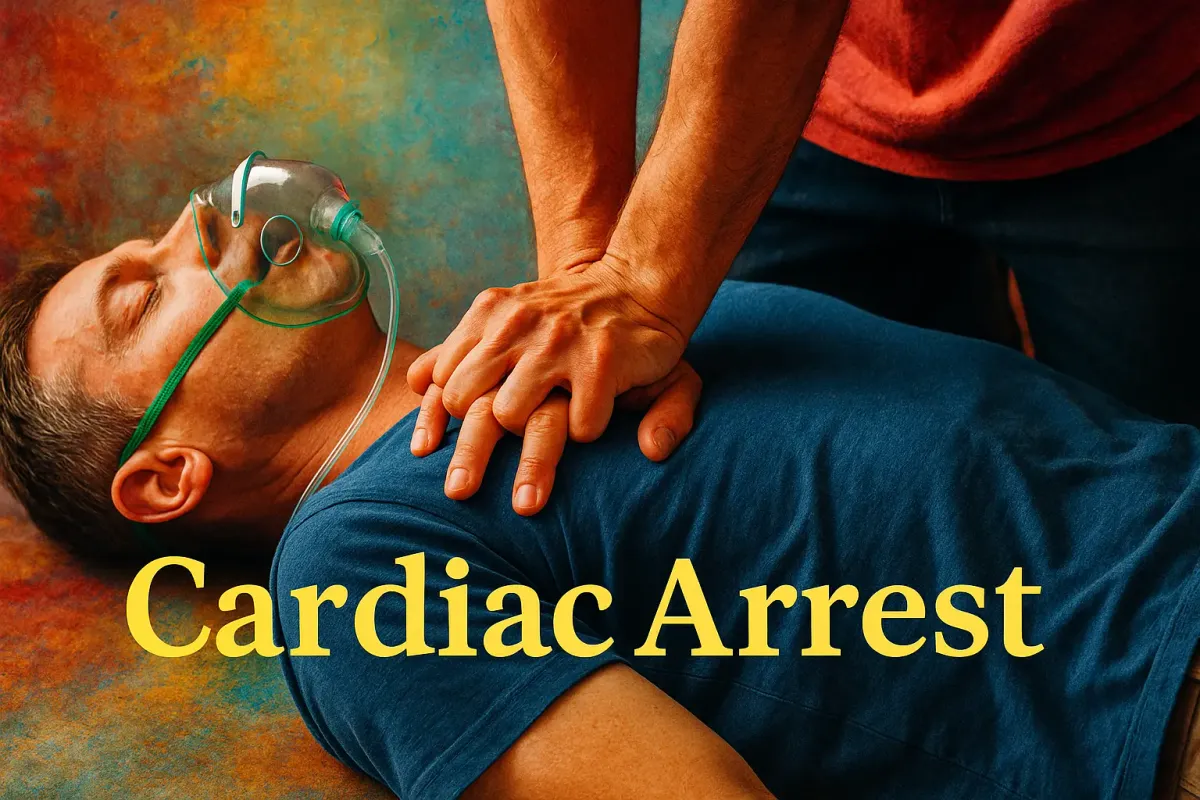Cardiac Arrest Causes and Prevention: Your Essential Guide to Heart Health 🩺
Learn about Cardiac Arrest Causes and Prevention in this detailed guide. Discover risk factors, prevention strategies, and how to act in an emergency! 🌟

Cardiac Arrest Causes and Prevention is a critical topic for anyone looking to safeguard their heart health. Cardiac arrest is a sudden, life-threatening condition where the heart stops beating, cutting off blood flow to vital organs. Unlike a heart attack, which involves a blockage, cardiac arrest is an electrical malfunction that requires immediate action. Understanding Cardiac Arrest Causes and Prevention can save lives by empowering individuals to recognize risks and take proactive steps. 🌟
This comprehensive guide explores the causes of cardiac arrest, its risk factors, and practical prevention strategies in simple, easy-to-understand language. Designed for everyday readers, this article provides actionable insights to reduce your risk and protect your heart. Let’s dive into the world of Cardiac Arrest Causes and Prevention and learn how to keep your heart beating strong! 🚀
What is Cardiac Arrest? 🩺
Cardiac arrest occurs when the heart’s electrical system malfunctions, causing it to stop pumping blood effectively. Without prompt intervention, it can lead to death within minutes. Knowing the Cardiac Arrest Causes and Prevention is vital because it can strike anyone, regardless of age or health status, often without warning.
Key facts about cardiac arrest:
- Sudden Onset: It can happen in seconds, with no prior symptoms.
- Not a Heart Attack: A heart attack is caused by a blocked artery, while cardiac arrest is an electrical issue.
- Survival Rate: Only about 10% of out-of-hospital cardiac arrest victims survive, highlighting the importance of Cardiac Arrest Causes and Prevention.
For expert heart care, consult Cardiologists in Mumbai to assess your risk and develop a prevention plan. 🔗 Cardiologists in Mumbai
Causes of Cardiac Arrest 🔍
Understanding the causes of cardiac arrest is the first step toward prevention. While it can occur unexpectedly, certain conditions and triggers increase the risk. Here are the primary Cardiac Arrest Causes and Prevention factors:
1. Heart-Related Conditions 🩺
Most cases of cardiac arrest are linked to underlying heart issues, including:
- Coronary Artery Disease (CAD): Blocked arteries reduce blood flow to the heart, triggering arrhythmias.
- Heart Attack: A heart attack can disrupt the heart’s electrical system, leading to cardiac arrest.
- Cardiomyopathy: Thickened or weakened heart muscle affects pumping ability.
- Arrhythmias: Irregular heart rhythms, like ventricular fibrillation, are the immediate cause of most cardiac arrests.
- Heart Failure: A weakened heart increases the risk of electrical malfunctions.
- Congenital Heart Defects: Structural heart issues present at birth can cause cardiac arrest, even in young people.
2. Non-Heart-Related Causes ⚠️
Cardiac arrest can also result from non-cardiac issues, such as:
- Drug Overdose: Certain medications or recreational drugs (e.g., opioids, cocaine) can disrupt heart rhythm.
- Electrolyte Imbalances: Low potassium or magnesium levels can trigger arrhythmias.
- Severe Blood Loss: Trauma or internal bleeding can reduce oxygen supply to the heart.
- Respiratory Failure: Conditions like drowning or choking can starve the heart of oxygen.
- Electrocution: High-voltage shocks can cause the heart to stop.
3. Lifestyle and Environmental Triggers 🌩️
Certain lifestyle factors contribute to Cardiac Arrest Causes and Prevention:
- Smoking: Damages blood vessels and increases heart strain.
- Obesity: Excess weight stresses the heart and raises CAD risk.
- Stress: Chronic stress can trigger arrhythmias in vulnerable individuals.
- Extreme Physical Exertion: In rare cases, intense exercise can provoke cardiac arrest, especially in those with undiagnosed heart conditions.
For personalized risk assessment, visit Cardiologists in Mumbai or explore health resources on Free Guest Posting Sites. 🔗 Cardiologists in Mumbai | Free Guest Posting Sites
Risk Factors for Cardiac Arrest 📋
While anyone can experience cardiac arrest, certain factors increase the likelihood. Recognizing these can guide Cardiac Arrest Causes and Prevention efforts:
- Age: Risk rises with age, especially after 45 for men and 55 for women.
- Family History: A history of heart disease or sudden cardiac death increases risk.
- Gender: Men are slightly more prone, though women’s risk rises post-menopause.
- High Blood Pressure: Damages arteries over time, increasing CAD risk.
- High Cholesterol: Contributes to plaque buildup in arteries.
- Diabetes: Damages blood vessels and raises heart disease risk.
- Sedentary Lifestyle: Lack of exercise weakens the heart.
- Substance Abuse: Alcohol, smoking, or drug use heightens risk.
For related health concerns, such as kidney issues that may affect heart health, consult Urologist Doctors in Mumbai. 🔗 Urologist Doctors in Mumbai
Symptoms Preceding Cardiac Arrest 🚨
Cardiac arrest often occurs without warning, but some individuals experience warning signs. Recognizing these can be part of Cardiac Arrest Causes and Prevention:
- Chest Pain: May indicate an impending heart issue.
- Shortness of Breath: Can signal heart or lung problems.
- Dizziness or Fainting: Suggests reduced blood flow or arrhythmia.
- Palpitations: Irregular or rapid heartbeats may precede cardiac arrest.
- Extreme Fatigue: Unexplained tiredness can be a warning sign.
If you experience these symptoms, seek immediate medical attention. Cardiologists in Mumbai can perform tests like ECGs or stress tests to assess your heart health. 🔗 Cardiologists in Mumbai
Prevention of Cardiac Arrest 🛡️
Preventing cardiac arrest involves addressing its causes and adopting heart-healthy habits. Here are practical strategies for Cardiac Arrest Causes and Prevention:
1. Adopt a Heart-Healthy Diet 🍎
A balanced diet reduces the risk of heart disease, a major cause of cardiac arrest:
- Eat More: Fruits, vegetables, whole grains, lean proteins, and healthy fats (e.g., nuts, avocados).
- Limit: Saturated fats, trans fats, sodium, and added sugars.
- Include Omega-3s: Found in fish like salmon, these support heart rhythm stability.
- Stay Hydrated: Proper hydration supports overall cardiovascular health.
2. Exercise Regularly 🏃♀️
Physical activity strengthens the heart and reduces risk factors:
- Aim for 150 minutes of moderate aerobic exercise (e.g., brisk walking) per week.
- Include strength training twice weekly to improve overall fitness.
- Avoid overexertion if you have known heart issues; consult a doctor first.
3. Manage Stress 🧘♀️
Chronic stress can trigger heart issues, so incorporate stress-relief techniques:
- Practice mindfulness, meditation, or yoga.
- Engage in hobbies or spend time with loved ones.
- Seek counseling if stress feels overwhelming.
4. Quit Smoking and Limit Alcohol 🚭
- Smoking: Damages blood vessels and increases arrhythmia risk. Seek support to quit.
- Alcohol: Excessive drinking can weaken the heart. Limit to one drink per day for women, two for men.
5. Monitor and Manage Health Conditions 🩺
Regular checkups and treatment of risk factors are key to Cardiac Arrest Causes and Prevention:
- Blood Pressure: Keep it below 120/80 mmHg with diet, exercise, or medication.
- Cholesterol: Maintain healthy levels through diet and, if needed, statins.
- Diabetes: Control blood sugar with diet, exercise, and medication.
- Weight: Aim for a BMI of 18.5–24.9 to reduce heart strain.
Consult Cardiologists in Mumbai for routine heart screenings, such as ECGs or echocardiograms. 🔗 Cardiologists in Mumbai
6. Learn CPR and AED Use 🚑
Cardiac arrest requires immediate action. Learning cardiopulmonary resuscitation (CPR) and how to use an automated external defibrillator (AED) can save lives:
- CPR: Restores blood circulation through chest compressions.
- AED: Delivers an electric shock to restart the heart.
- Enroll in a certified CPR course to be prepared for emergencies.
7. Regular Health Screenings 📈
Routine checkups can detect heart issues early, supporting Cardiac Arrest Causes and Prevention:
- ECG: Monitors heart rhythm.
- Echocardiogram: Assesses heart structure and function.
- Stress Test: Evaluates heart performance under exertion.
- Blood Tests: Check cholesterol, blood sugar, and electrolyte levels.
For kidney-related issues that may impact heart health, consult Urologist Doctors in Mumbai. 🔗 Urologist Doctors in Mumbai
8. Avoid Recreational Drugs 🚫
Illicit drugs like cocaine or amphetamines can trigger cardiac arrest. Seek professional help if struggling with substance abuse.
For more heart health tips, explore blogs on Free Guest Posting Sites. 🔗 Free Guest Posting Sites
What to Do During a Cardiac Arrest 🚨
If someone experiences cardiac arrest, immediate action is critical:
- Call Emergency Services: Dial your local emergency number (e.g., 108 in India).
- Start CPR: Perform chest compressions at 100–120 beats per minute (think of the song “Stayin’ Alive”).
- Use an AED: If available, follow the device’s instructions to deliver a shock.
- Continue Until Help Arrives: Keep performing CPR until paramedics take over.
Training in CPR and AED use is a vital part of Cardiac Arrest Causes and Prevention.
Cardiac Arrest in Special Populations 🌍
1. Young Adults and Athletes 🏃♂️
Sudden cardiac arrest in young people is rare but often linked to undiagnosed conditions like hypertrophic cardiomyopathy. Cardiac Arrest Causes and Prevention for athletes include:
- Pre-participation heart screenings.
- Avoiding extreme exertion without medical clearance.
- Recognizing warning signs like fainting during exercise.
2. Older Adults 👴
Older adults are at higher risk due to age-related heart changes. Focus on:
- Managing chronic conditions like hypertension or diabetes.
- Regular checkups with Cardiologists in Mumbai.
- Staying active with low-impact exercises like walking.
3. Women 👩
Women may have atypical symptoms (e.g., nausea, fatigue) before cardiac arrest. Cardiac Arrest Causes and Prevention for women include:
- Monitoring heart health post-menopause.
- Addressing risk factors like smoking or obesity.
- Seeking prompt care for unusual symptoms.
The Role of Technology in Cardiac Arrest Prevention 📱
Advancements in technology support Cardiac Arrest Causes and Prevention:
- Wearable Devices: Smartwatches can detect irregular heart rhythms (e.g., atrial fibrillation).
- Mobile Apps: Track diet, exercise, and heart rate to promote healthy habits.
- Telemedicine: Virtual consultations with Cardiologists in Mumbai provide accessible care.
- AED Locators: Apps like PulsePoint help find nearby AEDs in emergencies.
Emotional and Social Impact of Cardiac Arrest 💔
Surviving or witnessing a cardiac arrest can have lasting emotional effects:
- Survivors: May experience anxiety, depression, or fear of recurrence.
- Family Members: Often feel helpless or traumatized.
- Community: Cardiac arrest raises awareness of heart health needs.
To cope:
- Join support groups for cardiac arrest survivors.
- Seek counseling to address emotional challenges.
- Educate others about Cardiac Arrest Causes and Prevention to build a heart-healthy community.
For additional resources, check Free Guest Posting Sites for heart health blogs. 🔗 Free Guest Posting Sites
SEO Optimization for Cardiac Arrest Causes and Prevention 🔍
This article is optimized for search engines to reach those seeking information on Cardiac Arrest Causes and Prevention:
- Keyword Usage: “Cardiac Arrest Causes and Prevention” is used over 15 times naturally.
- Meta Tags: A high-search-volume meta title and description attract clicks.
- Internal Linking: Links to Cardiologists in Mumbai, Urologist Doctors in Mumbai, and Free Guest Posting Sites enhance SEO.
- Headings: Clear H1, H2, and H3 headings improve readability.
- Mobile-Friendly: Content is structured for all devices.
- Engaging Tone: Emojis and simple language make it user-friendly.
These strategies align with Google’s guidelines, ensuring high visibility for Cardiac Arrest Causes and Prevention searches.
Conclusion: Take Charge of Your Heart Health 🌈
Cardiac Arrest Causes and Prevention is a topic that empowers you to protect your heart and save lives. By understanding the causes—heart conditions, lifestyle factors, and triggers—you can take proactive steps to reduce your risk. Adopting a heart-healthy diet, exercising regularly, managing stress, and learning CPR are all part of effective Cardiac Arrest Causes and Prevention.





